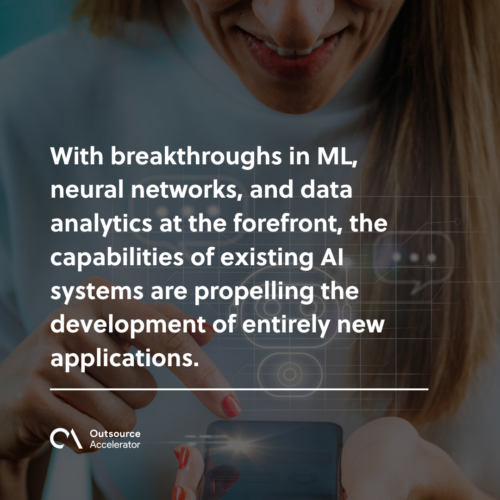The revolution continues: 12 AI trends to watch out for

Artificial Intelligence (AI) has already started changing how we live and operate.
From voice assistants like Siri and Alexa to recommendation algorithms on streaming platforms, AI is already woven into the fabric of our daily lives.
It streamlines tasks, offers insights, and even predicts our preferences. And the change will only get more widespread and transformative with each passing year.
The AI revolution isn’t slowing down; if anything, it’s gaining momentum.
So we’ve listed the top 12 AI trends to watch out for in the near future.
A current look into AI evolution
Since the inception of AI, machines have evolved from gradually understanding speech and recognizing text. Now, it can make diagnoses, offer recommendations, and even generate or manipulate content.
AI built on deep learning and machine learning (ML) algorithms are increasingly used for:
- Conflict mitigation
- Traffic regulation
- Business operations
With breakthroughs in ML, neural networks, and data analytics at the forefront, the capabilities of existing AI systems are propelling the development of entirely new applications.

How AI trends shape the present and future
The impact of AI trends reverberates across industries — from transforming customer experiences to optimizing business processes.
Its fusion with various technologies is driving us towards an era where AI-driven solutions are integral to daily life.
In fact, the rise of AI’s use is prompting the development and marketing of new products with it as a central feature.
Moreover, users are gaining more confidence in AI. That’s because we are seeing its practical application and benefits.
AI also lets businesses and industry players:
- Automate workflows
- Perform more analyses
- Create stronger customer relationships
The revolution has only just started and AI will conquer many more fields in the near future.
Importance of tracking AI trends
Staying abreast of AI trends isn’t just a matter of curiosity — it’s a strategic imperative.
Understanding these trends empowers businesses to leverage AI’s potential fully and make informed decisions that position them ahead of the curve.
AI innovations also promise progress and success — whether it leads to better automation, management, or predictions.
That’s why there’s always a need to stay informed of emerging AI trends and plan accordingly to reap the following benefits:
- Competitive advantage. Tracking AI trends allows us to stay ahead of the competition by leveraging its latest technologies and innovations.
- Strategic decision-making. Keeping up with trends helps companies make informed decisions that align with their goals and objectives.
- Enhanced efficiency. Knowing AI trends helps streamline processes, reduce manual labor, and improve productivity.
- Improved customer experience. By tracking relevant trends, enterprises can provide personalized experiences, optimize customer engagement, and meet customer expectations.
- Talent acquisition and retention. Companies that stay updated with the latest trends can attract and retain top talent by offering opportunities to work with cutting-edge technologies.
- Risk mitigation. There are AI trends that focus on advancements in cybersecurity and risk mitigation. Being aware of them aids in protecting sensitive data and proactively responding to threats.
- Innovation and expansion. AI trends pave the way for new opportunities and innovations, enabling firms to diversify and expand their business.
- Collaboration and team performance. Trends in AI contribute to better communication, automation of repetitive tasks, and enhanced decision-making within teams.
Top 12 AI trends we can anticipate
As we step into the future, staying attuned to the emerging fads shaping the AI landscape is essential.
Here are the most prominent AI trends to look out for:
1. More advanced conversational AI systems
As conversational AI matures, we can expect more natural and human-like interactions with virtual assistants.
Innovations like OpenAI’s GPT-4 represent this evolution. Applications like that allow AI to understand context, nuances, and emotions in conversations.

2. Better collaboration between humans and AI
Collaborative AI models will blur the line between human and machine contributions.
By merging human expertise with AI’s analytical capabilities, organizations can harness both the analytical and creative aspects of problem-solving.
3. AI filling in the gaps of a globalized workforce
As remote work gains permanence, AI’s role in bridging gaps among a geographically dispersed workforce becomes essential.
Real-time language translation and intelligent content curation tools are prime examples of how AI facilitates seamless collaboration.
Additionally, AI trends in automation will allow for quick and efficient:
- Assessment of potential employees
- Sorting potential candidates
- Grading of job applicants
4. Improvement of generative AI
Generative AI models are becoming more sophisticated in creating authentic content, from art to music and even code.
These computer-generated outputs are indistinguishable from human creations, opening new vistas for creativity and efficiency. One example of this improvement is the ability to generate realistic and high-quality synthetic images.
Generative adversarial networks (GANs) have made significant advancements in creating images that are difficult to distinguish from real photographs.
These AI-generated images can be used for various applications, such as:
- Virtual reality (VR)
- Video game development
- Product design
- Generating realistic fake faces for marketing or artistic purposes
5. Better cybersecurity with AI
As cyber threats evolve, AI-driven cybersecurity solutions become vital.
ML systems can analyze vast amounts of data to detect patterns and anomalies. These help fortify digital defenses against sophisticated attacks.
6. Low-code or no-code development carried over AI
Low-code or no-code development will become more popular. AI and ML-powered platforms will let businesses create complex digital solutions quickly and cheaply.
According to Business Wire, platform development using low-code or no-code tools costs 70% lower.
7. Rise of digital twinning
Digital twinning is the next evolution of IoT, where a digital replica or copy of a physical object is created and virtually tested.
Enhancing digital twinning will be a new arena for AI, where it can enhance the replica’s accuracy and accurately forecast how it would perform in different circumstances.
8. Overcoming language barriers with NLP
There are more than 7000 languages globally. Advancements in natural language processing (NLP) will enable fast and efficient translation of these languages.
As a result, it opens up more opportunities for trade, collaboration, and knowledge sharing. This is a game-changer for global business interactions and cultural exchanges.
9. AI in voice technology
As seen in Amazon’s Alexa and Google Assistant, voice control technology is becoming more omnipresent as part of AI.
Voice technology’s familiarity, user experience, access to hands-free messages, and quick assistance in simple tasks have all contributed to its success.
In voice biometrics, AI algorithms can analyze various aspects of a person’s voice. These can include pitch, tone, cadence, and pronunciation that help create a voiceprint unique to an individual.
AI-assisted voice biometrics can be used for:
- Secure access to systems
- Authorization of transactions
- Voice-based user verification in applications like banking, customer service, and security systems
Another application of AI in voice technology is voice cloning.
Algorithms can analyze and learn from a person’s voice recordings to generate speech that sounds like the person speaking.
This can be used for various purposes, including voice assistance, audiobook narration, and dubbing in movies or commercials.
Voice cloning can also have practical applications, such as:
- Creating synthetic voices for individuals with speech disorders
- Preserving the voices of loved ones who have passed away
10. AI in the automotive industry
Self-driving cars are merely scratching the surface of AI’s potential in the automotive sector. AI is also revolutionizing automotive safety, predictive maintenance, and even urban planning.
There’s a move in the industry for promising safer, more efficient transportation systems.
Companies like Tesla and Waymo are actively working on integrating AI technology into their autonomous car systems. Furthermore, AI is used in advanced driver assistance systems (ADAS) to enhance vehicle safety features.
For example, AI systems can analyze information from sensors to:
- Detect and warn drivers about potential collisions
- Assist with lane-keeping
- Monitor driver fatigue
- Provide adaptive cruise control
These AI-powered ADAS features are increasingly being integrated into modern cars from various manufacturers, aiming to improve road safety and reduce accidents.

11. AI in healthcare
AI is already being used to detect diseases or manage healthcare. However, its growth and adoption will bring about greater efficiency, accuracy, and determinacy.
AI will enable things such as:
- Speedy diagnosis
- Remote consultation
- Electronic health management
- Drug discoveries
AI’s integration into healthcare functions will drive better health-related outcomes.
Plus, AI provides the ability to process vast amounts of medical data in real time, revolutionizing patient care and medical research.
12. Using AI for personalization
For a long time, ‘personalization’ has been a buzzword across any industry. Individualized and automated content creation and delivery will become a reality with AI.
This will help companies refine their target audience and provide individualized customer experiences.
One instance of using AI for personalization is in e-commerce and online retail. Algorithms are used to analyze massive amounts of information, including:
- Customer behavior
- Preferences
- Purchase history
- Contextual data like location and weather conditions
This analysis allows AI systems to make personalized product recommendations to individual customers.
AI can also personalize the user experience on websites and apps by dynamically presenting relevant content based on individual preferences.
For example, news websites can use algorithms to suggest articles based on a user’s reading history and interests.
Similarly, streaming platforms like Netflix and Spotify leverage AI to offer personalized movie and music recommendations.







 Independent
Independent




